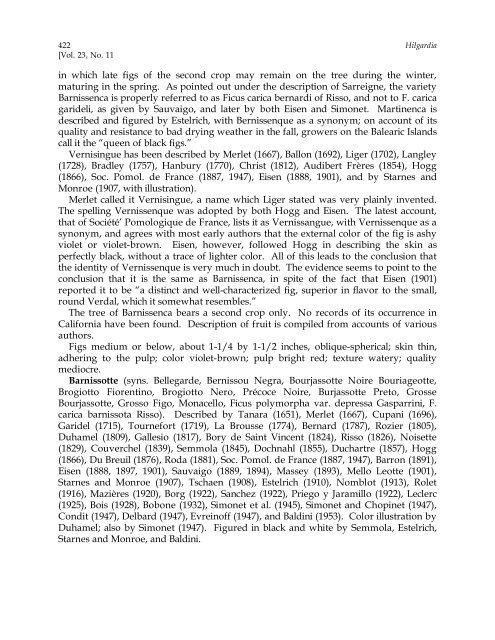Fig Varieties: A Monograph - uri=ucce.ucdavis
Fig Varieties: A Monograph - uri=ucce.ucdavis
Fig Varieties: A Monograph - uri=ucce.ucdavis
Create successful ePaper yourself
Turn your PDF publications into a flip-book with our unique Google optimized e-Paper software.
422 Hilgardia<br />
[Vol. 23, No. 11<br />
in which late figs of the second crop may remain on the tree during the winter,<br />
maturing in the spring. As pointed out under the description of Sarreigne, the variety<br />
Barnissenca is properly referred to as Ficus carica bernardi of Risso, and not to F. carica<br />
garideli, as given by Sauvaigo, and later by both Eisen and Simonet. Martinenca is<br />
described and figured by Estelrich, with Bernissenque as a synonym; on account of its<br />
quality and resistance to bad drying weather in the fall, growers on the Balearic Islands<br />
call it the “queen of black figs.”<br />
Vernisingue has been described by Merlet (1667), Ballon (1692), Liger (1702), Langley<br />
(1728), Bradley (1757), Hanbury (1770), Christ (1812), Audibert Frères (1854), Hogg<br />
(1866), Soc. Pomol. de France (1887, 1947), Eisen (1888, 1901), and by Starnes and<br />
Monroe (1907, with illustration).<br />
Merlet called it Vernisingue, a name which Liger stated was very plainly invented.<br />
The spelling Vernissenque was adopted by both Hogg and Eisen. The latest account,<br />
that of Société’ Pomologique de France, lists it as Vernissangue, with Vernissenque as a<br />
synonym, and agrees with most early authors that the external color of the fig is ashy<br />
violet or violet-brown. Eisen, however, followed Hogg in describing the skin as<br />
perfectly black, without a trace of lighter color. All of this leads to the conclusion that<br />
the identity of Vernissenque is very much in doubt. The evidence seems to point to the<br />
conclusion that it is the same as Barnissenca, in spite of the fact that Eisen (1901)<br />
reported it to be “a distinct and well-characterized fig, superior in flavor to the small,<br />
round Verdal, which it somewhat resembles.”<br />
The tree of Barnissenca bears a second crop only. No records of its occurrence in<br />
California have been found. Description of fruit is compiled from accounts of various<br />
authors.<br />
<strong>Fig</strong>s medium or below, about 1-1/4 by 1-1/2 inches, oblique-spherical; skin thin,<br />
adhering to the pulp; color violet-brown; pulp bright red; texture watery; quality<br />
mediocre.<br />
Barnissotte (syns. Bellegarde, Bernissou Negra, Bourjassotte Noire Bouriageotte,<br />
Brogiotto Fiorentino, Brogiotto Nero, Précoce Noire, Burjassotte Preto, Grosse<br />
Bourjassotte, Grosso <strong>Fig</strong>o, Monacello, Ficus polymorpha var. depressa Gasparrini, F.<br />
carica barnissota Risso). Described by Tanara (1651), Merlet (1667), Cupani (1696),<br />
Garidel (1715), Tournefort (1719), La Brousse (1774), Bernard (1787), Rozier (1805),<br />
Duhamel (1809), Gallesio (1817), Bory de Saint Vincent (1824), Risso (1826), Noisette<br />
(1829), Couverchel (1839), Semmola (1845), Dochnahl (1855), Duchartre (1857), Hogg<br />
(1866), Du Breuil (1876), Roda (1881), Soc. Pomol. de France (1887, 1947), Barron (1891),<br />
Eisen (1888, 1897, 1901), Sauvaigo (1889, 1894), Massey (1893), Mello Leotte (1901),<br />
Starnes and Monroe (1907), Tschaen (1908), Estelrich (1910), Nomblot (1913), Rolet<br />
(1916), Mazières (1920), Borg (1922), Sanchez (1922), Priego y Jaramillo (1922), Leclerc<br />
(1925), Bois (1928), Bobone (1932), Simonet et al. (1945), Simonet and Chopinet (1947),<br />
Condit (1947), Delbard (1947), Evreinoff (1947), and Baldini (1953). Color illustration by<br />
Duhamel; also by Simonet (1947). <strong>Fig</strong>ured in black and white by Semmola, Estelrich,<br />
Starnes and Monroe, and Baldini.
















![Fig Trees in North Carolina [Archive] - IDigMyGarden ... - Figs 4 Fun](https://img.yumpu.com/26905320/1/190x245/fig-trees-in-north-carolina-archive-idigmygarden-figs-4-fun.jpg?quality=85)